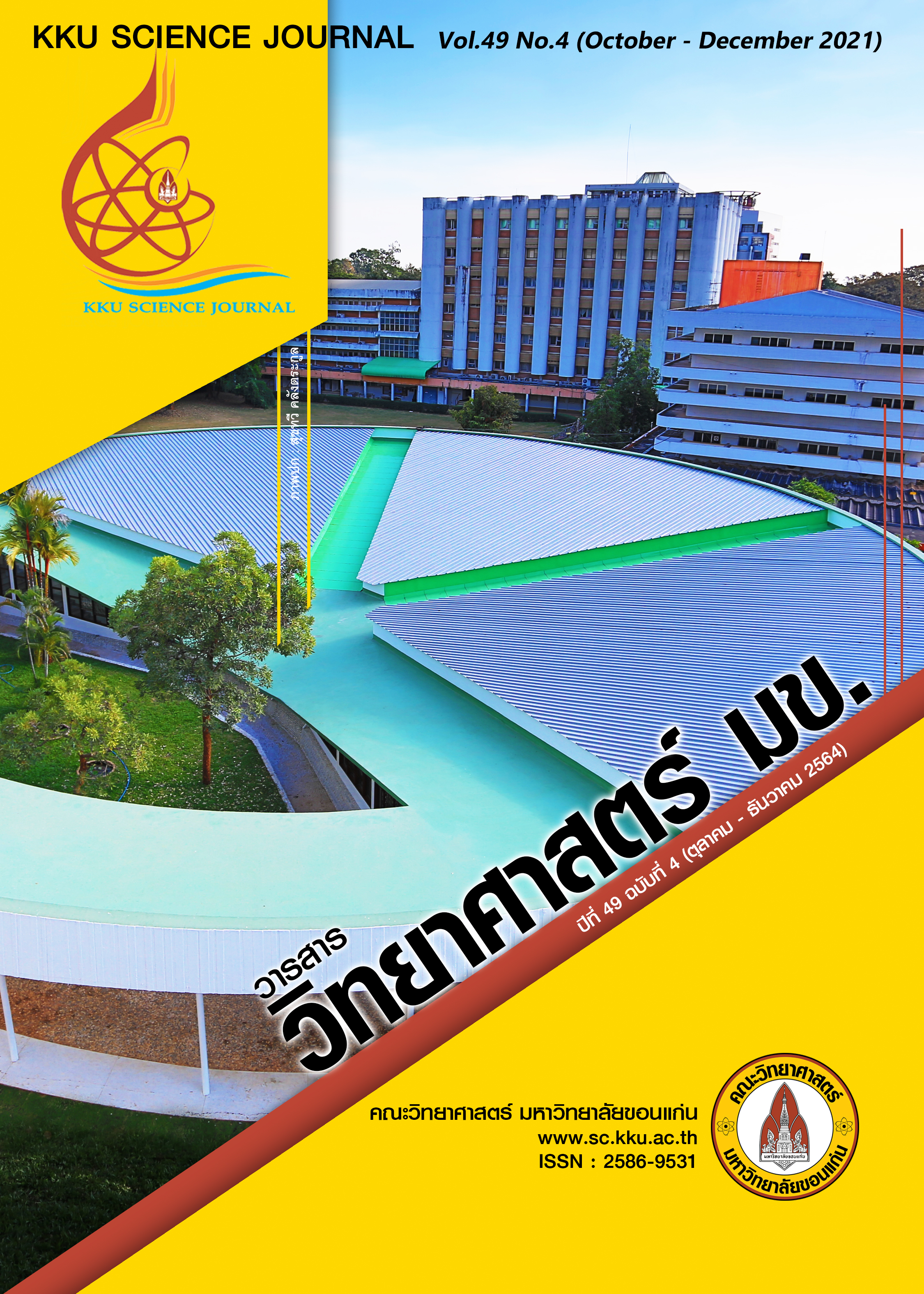DNA analysis in Forensic Science
Main Article Content
Abstract
Forensic DNA analysis has long been serving as a powerful investigative technique in forensic science. It is used to assist criminal investigations not only in convicting suspects but also in exonerating the innocent. It is also used in parentage testing as well as a standard test for identifying immigration eligibility. This review article contributes scientific knowledge of current practice for DNA analysis used in forensic applications. The article provides general introduction to DNA and how is DNA inherited as well as its use as a forensic science tools for human identification. The discovery and development of DNA fingerprinting technique as well as paternal line analysis using Y-chromosome will be mentioned. A brief insight into future areas of development in relation to forensic DNA analysis will also be discussed.
Article Details

This work is licensed under a Creative Commons Attribution-NonCommercial-NoDerivatives 4.0 International License.
References
Al-Rashedi, N. A. M., Mandal, A. M. and Alobaidi, L. A. H. (2020). Eye color prediction using the IrisPlex system: a limited pilot study in the Iraqi population. Egyptian Journal of Forensic Sciences 10(1): 27.
Amorim, A., Fernandes, T. and Taveira, N. (2019). Mitochondrial DNA in human identification: a review. PeerJ 7: e7314-e7314.
Blanco, A. and Blanco, G. (2017). Chapter 6 - Nucleic Acids. In A. Blanco and G. Blanco (Eds.). Medical Biochemistry.
Academic Press. pp. 121-140.
Butler, J. M. (2012). Chapter 17 - New Technologies and Automation. In J. M. Butler (Ed.). Advanced Topics in
Forensic DNA Typing: Methodology. San Diego: Academic Press. pp. 497-514.
Butler, J. M. (2015). The future of forensic DNA analysis. Philosophical Transactions of the Royal Society B: Biological Sciences 370(1674): 20140252.
Butler, J. M. and Levin, B. C. (1998). Forensic applications of mitochondrial DNA. Trends in Biotechnology16(4): 158-
Christensen, A. M., Passalacqua, N. V. and Bartelink, E. J. (2019). Chapter 14 - Personal identification. In A. M.
Christensen, N. V. Passalacqua, and E. J. Bartelink (Eds.). Forensic Anthropology (Second Edition). Academic
Press. pp. 443-468.
Dahm, R. (2005). Friedrich Miescher and the discovery of DNA. Developmental Biology 278(2): 274-288.
Dembinski, G. M. and Picard, C. J. (2014). Evaluation of the IrisPlex DNA-based eye color prediction assay in a United
States population. Forensic Science International: Genetics 9: 111-117.
Franklin, R. E. and Gosling, R. G. (1953). Molecular Configuration in Sodium Thymonucleate. Nature 171(4356): 740-741.
Giannelli, P. C. (1997). The DNA Story: An Alternative View. (And the Blood Cried out, Harlan Levy). The Journal of
Criminal Law and Criminology (1973-) 88(1): 380-422.
Herrera, R. J. and Garcia-Bertrand, R. (2018). Chapter 1 - The Nature of Evolution. In R. J. Herrera and R. GarciaBertrand (Eds.). Ancestral DNA, Human Origins, and Migrations. Academic Press. pp. 1-31.
Jeffreys, A. J., Brookfield, J. F. and Semeonoff, R. (1985). Positive identification of an immigration test-case using human DNA fingerprints. Nature 317(6040): 818-819.
Jeffreys, A. J., Wilson, V. and Thein, S. L. (1985a). Hypervariable'minisatellite' regions in human DNA. Nature 314(6006): 67-73.
Jeffreys, A. J., Wilson, V. and Thein, S. L. (1985b). Individualspecific ‘fingerprints’ of human DNA. Nature 316(6023): 76-79.
Kayser, M. (2015). Forensic DNA Phenotyping: Predicting human appearance from crime scene material for investigative purposes. Forensic Science International: Genetics 18: 33-48.
Kayser, M. (2017). Forensic use of Y-chromosome DNA: a general overview. Human genetics 136(5): 621-635.
Kumar, S. R. B. and Newfeld, S. J. (2002). Modern Genetic Analysis: Integrating Genes and Genomes. By Anthony J F
Griffiths, William M Gelbart, Richard C Lewontin, and Jeffrey H Miller. The Quarterly Review of Biology 77(4): 456-457.
Maddox, B. and Mcelheny, V. K. (2003). Rosalind Franklin: The Dark Lady of DNA. Journal of the History of Biology,
(3): 591-597.
Marano, L. and Fridman, C. (2019). DNA phenotyping: current application in forensic science. Research and Reports in Forensic Medical Science 9: 1-8.
Marwal, A., Sahu, A. K. and Gaur, R. K. (2014). Chapter 16 - Molecular Markers: Tool for Genetic Analysis. In A. S. Verma & A. Singh (Eds.) Animal Biotechnology. San Diego: Academic Press. pp. 289-305.
Nelson, D. L., Cox, M. M., & Lehninger, A. L. (2013). Lehninger principles of biochemistry. New York: W.H. Freeman
and Company.
Nelson, D. L., Cox, M. M. and Lehninger, A. L. (2017). Lehninger principles of biochemistry.
Pauling, L. and Corey, R. B. (1953). A Proposed Structure For The Nucleic Acids. Proceedings of the National Academy of Sciences of the United States of America. 39(2): 84-97.
Rerkamnuaychoke, B., Chantratita, W., Jomsawat, U., Thanakitgosate, J. and Rojanasunan, P. (2000). Forensic identification by DNA fingerprinting and mitochondrial DNA typing. Journal of the Medical Association of Thailand 83(3): 49-54.
Roewer, L. (2019). Y-chromosome short tandem repeats in forensics—Sexing, profiling, and matching male DNA.
WIREs Forensic Science 1(4): e1336.
Schneider, P. M., Prainsack, B. and Kayser, M. (2019). The Use of Forensic DNA Phenotyping in Predicting Appearance
and Biogeographic Ancestry. Deutsches Arzteblatt international 51-52(51-52): 873-880.
Stasiak, A. (2001). Rosalind Franklin. EMBO Reports 2(3): 181-181.
Voet, D. and Voet, J. G. (2010). Biochemistry, 4th Edition: W. Ross MacDonald School Resource Services Library.
Watson, J. D. and Crick, F. H. C. (1953). Molecular Structure of Nucleic Acids: A Structure for Deoxyribose Nucleic Acid.
Nature 171(4356): 737-738.
Wilkins, M. H. F., Stokes, A. R. and Wilson, H. R. (1953). Molecular Structure of Nucleic Acids: Molecular Structure of
Deoxypentose Nucleic Acids. Nature 171(4356): 738-740.
Wong, Z., Wilson, V., Patel, I., Povey, S. and Jeffreys, A. J. (1987). Characterization of a panel of highly variable minisatellites cloned from human DNA. Annals of Human Genetics 51(4): 269-288.
Yun, L., Gu, Y., Rajeevan, H. and Kidd, K. K. (2014). Application of six IrisPlex SNPs and comparison of two eye color
prediction systems in diverse Eurasia populations. International Journal of Legal Medicine 128(3): 447-453.
Zagorski, N. (2006). Profile of Alec J. Jeffreys. Proceedings of the National Academy of Sciences. 103(24): 8918.


